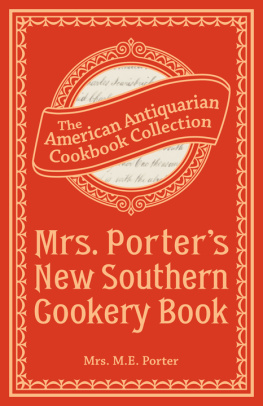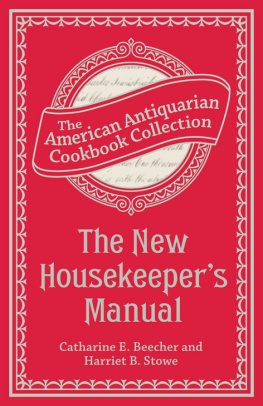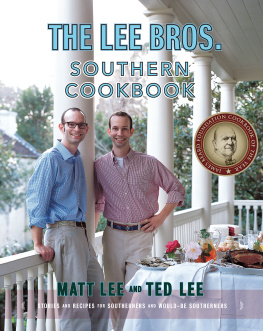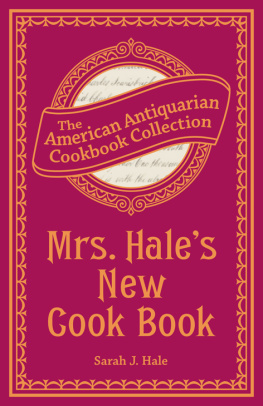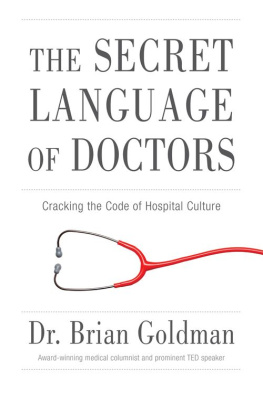

OTHER BOOKS IN
THE AMERICAN ANTIQUARIAN SOCIETY
COOKBOOK COLLECTION
American Cookery, by Amelia Simmons
The Canadian Housewifes Manual of Cookery
The Compleat Housewife, by Eliza Smith
The Cook Not Mad
Cottage Economy, by William Cobbett
Dainty Dishes, by Lady Harriet E. St. Clair
Dairying Exemplified, by Josiah Twamley
Fifteen Cent Dinners for Families of Six, by Juliet Corson
The Hand-Book of Carving
How to Mix Drinks, by Jerry Thomas
Jewish Cookery Book, by Esther Levy
Miss Leslies New Cookery Book, by Eliza Leslie
Mrs. Owens Illinois Cook Book, by Mrs. T.J.V. Owen
The New England Cook Book
The Physiology of Taste, by Jean A. Brillat-Savarin
The Times Recipes, by The New York Times
A Treatise on Bread, by Sylvester Graham
Vegetable Diet, by William Alcott
What to Do with the Cold Mutton

This edition of Mrs. Porter's New Southern Cookery Book by Mrs. M.E. Porter was reproduced by permission from the volume in the collection of the American Antiquarian Society (AAS), Worcester, Massachusetts. Founded in 1812 by Isaiah Thomas, a Revolutionary War patriot and successful printer and publisher, the Society is a research library documenting the life of Americans from the colonial era through 1876. AAS aims to collect, preserve, and make available as complete a record as possible of the printed materials from the early American experience. The cookbook collection includes approximately 1,100 volumes.
Mrs. Porter's New Southern Cookery Book copyright 2012 by American Antiquarian Society. All rights reserved. No part of this book may be used or reproduced in any manner whatsoever without written permission except in the case of reprints in the context of reviews.
Andrews McMeel Publishing, LLC
an Andrews McMeel Universal company
1130 Walnut Street, Kansas City, Missouri 64106
www.andrewsmcmeel.com
ISBN: 978-1-4494-2828-0
ATTENTION: SCHOOLS AND BUSINESSES
Andrews McMeel books are available at quantity discounts with bulk purchase for educational, business, or sales promotional use. For information, please e-mail the Andrews McMeel Publishing Special Sales Department:
specialsales@amuniversal.com

Entered according to Act of Congress, in the year 1871, by
JOHN E. POTTER AND COMPANY,
In the Office of the Librarian of Congress, at Washington.

PREFACE.

M UCH money has been squandered in misdirected efforts of well-meaning, painstaking housewives to supply their tables with palatable necessaries as well as luxuries of life; in vast numbers of instances, health has been impaired and the comfort and happiness of families marred by the ignorance of those who have the supervision of the culinary department. Quite a large number of books have been written and published with the commendable design of correcting this fault; some of these have been carefully prepared by competent writers, and have been excellent so far as they went, and yet they have not been so complete and perfect as to render improvement difficult or impracticable.
Those who examine this New Cookery Book cannot but acknowledge that we have no call to apologize for offering it to the public and expecting a large sale. Its intrinsic merits and superiority will readily be seen by those who critically analyze the recipes, and will certainly be proved by putting them to practical test. The recipes are from the pen of a lady whose experience and skill as a housekeeper would have justified us in publishing them without question, but to insure perfect reliability we have had them severally tested by competent housewives and successful cooks. But in addition to their reliability, we claim for these recipes that they are written in plain English, concisely yet clearly, so that none can mistake their meaning. In many cases, while giving the more elaborate and expensive mode of making certain articles, we have added cheaper and scarcely inferior methods.
One fact will impress those who use this book: it is that we have studied the interests of the user by giving the modes of making the most tempting luxuries, as well as the commoner necessaries, with the least possible outlay; in other words, our study has been to give the most economical as well as best methods of preparing the various viands.
Hoping that our efforts and care may tend to lighten the labors and anxieties of the painstaking housewives throughout our land, and be appreciated by them, and also by those whose tables are in consequence better and more economically supplied than before,
Respectfully,
T HE P UBLISHERS .
CONTENTS.

MRS. PORTERS
NEW
S OUTHERN C OOK -B OOK .
___________________________
HOW TO MAKE SOUPS.
_______________
GENERAL REMARKS.
G OOD meat is essential to good soup. It should be well boiled by the long and slow process, that the essence of the meat may be drawn out thoroughly, and the liquor should be carefully skimmed to prevent it from becoming turbid. When no more scum accumulates, and the meat is softened so as to readily separate with the use of the fork, the vegetables should be put in, the seasoning done, and the necessary amount of hot water added if too much has boiled away. A common camp-kettle will be found an excellent utensil for making soups, as the lid is heavy and will keep the steam in. An earthen pipkin or jar, if of a long and narrow make, widening a little at the centre, is perhaps one of the best vessels for soups, and is universally used by foreign cooks, who insist that it renders the gravy clearer and more limpid, and extracts more savor from the meat, than when made in tin or copper. The glutinous matters contained in the bones render it important that they should be boiled with the meat, as they add to the strength and thickness of the soup, although the meat should be cut off the bone and divided into small pieces, removing the fat. The following thickening is indispensable to all rich soups: A tablespoonful or more of flour, mixed to a smooth paste, with a little water and enriched with a teaspoonful of good butter or beef dripping; it should be well stirred in. If making a rich soup that requires catsup or wine, let it be added immediately before the soup is taken from the fire. Soup may be colored yellow with grated carrots; red with tomato juice; green with the juice of powdered spinach, and brown with carefully scorched flour kept ready for the purpose. The use of any of these is undoubtedly some improvement, both as to look and flavor. The soups contained in the following pages have been thoroughly tested, and their merits contrasted with numerous others of a similar character. They were found to be more palatable, nutritious, easily made and superior as a whole; they but need good ingredients.
Next page
